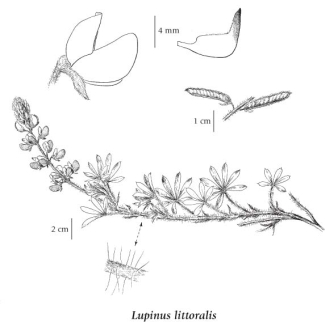seashore lupine
Fabaceae (Pea family)
Introduction to Vascular Plants
Introduction
Seashore lupine is a Pacific coast species that is found in North America from California north to British Columbia (Riggins and Sholars 1993). In California, seashore lupine is reported from coastal sand (Riggins and Sholars 1993); specifically it is reported from the Northern Coastal Bluff Scrub plant community in California, which is typified by exposure to high winds and salt spray (California State Parks 2008). In BC, it is found in moist sand dunes and beaches in the lowland zone, within the fog zone, and has been found on sand dredgings. Plantings of this species have occurred in Spanish Banks in Vancouver, and the resulting population is well-established.This is a distinctive, often prostrate species with long shaggy hairs particularly in the nodes. Flowers are blue-lilac. Hybrids with Lupinus arboreus have been observed in Fraser delta, with plants varying in morphology between both parents. Hybrids with other lupine species have been reported. The earliest collections of this species in the UBC Herbarium are by Charles E. Beil in 1974, from the Queen Charlotte Islands, and by Adolf and Oluna Ceska in 1974, from Point Holmes (Comox, Vancouver Island) and Sheringham Point (Vancouver Island).
|
Species Information
General:
Perennial herb; stems prostrate to decumbent, mat-forming, to 60 cm long, slender, freely branching, short-stiff-hairy and also with long soft spreading hairs.
Leaves:
Alternate, palmately compound with leaf stalks 1-2 times as long as the blades; leaflets 5 to 8, narrowly oblanceolate, blunt to rounded with an abrupt point at the tip, 1.5-3 cm long, glabrous or nearly so above, short-stiff-hairy below.
Flowers:
Inflorescence a stalked, loose, terminal raceme, 5-15 cm long, of whorled pea-like flowers, the racemes numerous; corollas blue to purplish often with some white, 11-13 mm long, the banner nearly circular, with a white central patch and glabrous on the back, shorter than the wings, the keel fringed with fine hairs along the upper edges; calyces 2-lipped, the lips about equal in size, the upper lip 2-toothed, the lower one entire.
Fruits:
Pods, 2-3.5 cm long, 6-8 mm wide, sparsely short-hairy; seeds 5 to 12, greyish but dark-mottled.
Illustration

If more than one illustration is available for a species (e.g., separate illustrations were provided for two subspecies) then links to the separate images will be provided below. Note that individual subspecies or varietal illustrations are not always available.
Illustration Source: The Illustrated Flora of British Columbia
Ecology
The table below shows the species-specific information calculated from
original data (BEC database) provided by the BC Ministry of Forests and Range.
(Updated August, 2013)
| Site Information |
Value / Class |
||
|
Avg |
Min |
Max |
|
| Elevation
(metres) |
11 | 11 | 11 |
| Slope
Gradient (%) |
0 | 0 | 0 |
|
Aspect (degrees) |
0 | ||
| Soil
Moisture Regime (SMR) [0 - very xeric; 4 - mesic; 8 - hydric] |
2 | 2 | 2 |
| Modal
Nutrient Regime
Class |
A | ||
| #
of field plots species was recorded in: |
1 | ||
| Modal
BEC Zone Class |
CWH | ||
|
All BEC Zones (# of stations/zone) species was recorded in |
CWH(1) | ||
|
Source:
Klinkenberg 2013
|
|||
Habitat and Range
Moist sand beaches and dunes in the lowland zone; infrequent along the coast; S to N CA.Status Information
Taxonomic Notes
Seashore lupine is a pioneer species, and is an early-occurring species in sand dune succession (Kumler 1969). As a pioneer species that does well in sandy conditions, it often appears in sand pre-load sites (sand dredgings) proximal to the coast. Thousands of plants have been observed at one site on Lulu Island in the Fraser Delta. This species is used in sand dune stabilization projects (e.g. Schwendiman 1977).
|
References
Kumler, M. L. 1969. Plant succession on the sand dunes of the Oregon coast. Ecology 50 (4): 695-704.
Riggins, Rhonda and Teresa Sholars. 1997. Jepson Manual treatment for Lupinus littoralis Douglas. In: Hickman, James C. The Jepson Manual of the Higher Plants of California. University of California Press, Los Angeles. Available Online.
Schwendiman, J. L. 1977. Coastal sand dune stabilization in the Pacific Northwest. International Journal of Biometeorology. 21 (3): 281-289.